Rio de Janeiro (Translation: “River of January”) is one of the most touristic cities in the world. The reason is the natural beauty – the mountains and sea are very close together. However, Rio is more expensive than the rest of Brazil, due to its reputation for tourism.
Along with seeing the Christ Statue up close at the Corcovado Mountain, and maybe taking the two cable cars up to Pão de Açúcar (Sugarloaf Mountain), you’ll find a lot of health and wellness activities throughout the city. This definitely includes going for a walk or run alongside both Ipanema and Copacabana Beach. Ipanema is the upmarket part of Rio with it’s classy and safer beaches. While, Copacabana is very cosmopolitan, somewhat less safe, and a more adventurous place to catch some sun.
Contents
Rio de Janeiro Food
Copacabana Street Food
Copacabana Beach is a tourist highlight by itself. Apart from being great for strolling and sight-seeing, on the promenade, you’ll find typical Rio de Janeiro snack foods. For example, “Milho Verde” – this is basically cooked maize with margarine and salt. Then, of course, the salted (or caramelized) Popcorn (“pipocas”). Also, the starchy Tapioca pancakes with a banana (or chicken) filling. Plus, you won’t miss the Acai berry smoothie, sweetened with Guarana Syrup.
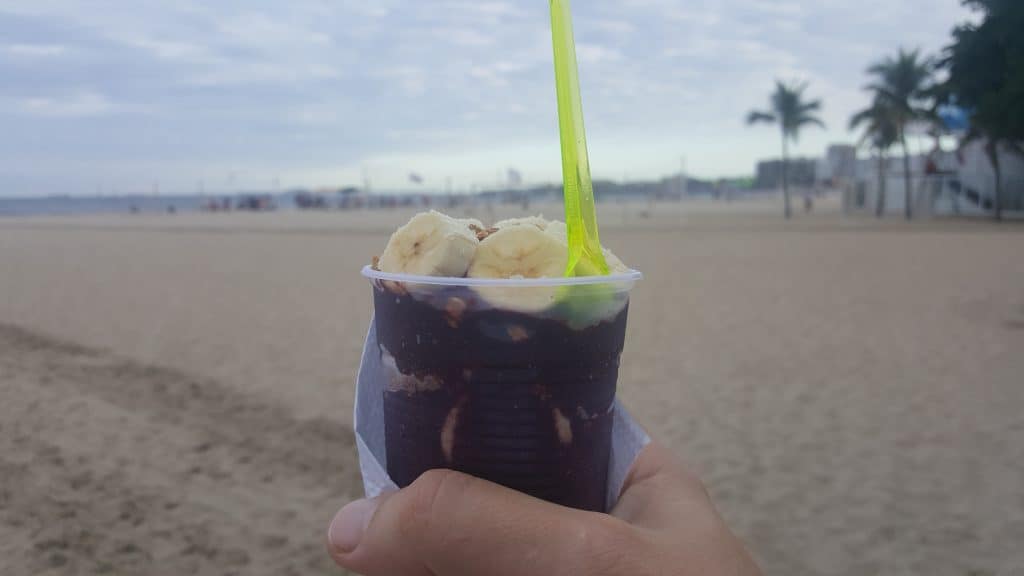
However, the main attraction is the healthy Coconut water, straight from the nut-shell. It’s definitely recommended to take advantage of this health-centric drink in Rio. The negative is that the white creamy flesh part of the fruit is wasted and thrown away. Otherwise, you could blend the Coco flesh with water and make your own fresh coconut milk. This is a much better alternative than canned, preserved coconut milk.

Rio Restaurants
Your first (less healthy) option is to get some vegan junk food like soya hamburgers. In Rio’s vegetarian or vegan restaurants, e.g. Las Vegans in Lapa, soya is very prominent. Otherwise, get a vegan deep fried rice sandwich at Brota. An innovative choice but not good for your health. Yet, they do have healthier options available such a vegetable “Ceviche”.
However, my own choice would be to visit a pay-by-weight restaurant like Temperarte. Here you’ll encounter plenty of healthy vegetable options and decent quality, unprocessed, cooked meat. The pay-by-weight restaurants charge around 70 Reals per kilo. The price can rise up to R$99/kilo during weekends. At these upmarket pay-by-weight restaurants, food can include expensive seafood such as Salmon steak, swordfish skewers, tuna fillet and prawns. In Copacabana, you’ll find quality food at lower prices. There are many good options. Temperarte used to be the best choice, but they’ve been semi-closed in 2021.
In 2021, the best Rio restaurant is Kilograma in Ipanema (Rua Visconde de Pirajá). They have an eat-all-you-can option for R$40, which is great value for money, since they also have plenty of healthier food options.
Unique Traditional Brazilian Foods
Farofa is a starch mixture made with Cassava root (a.k.a. Mandioca, Yuca). You’ll find it alongside almost all meals in Rio’s traditional restaurants (especially pay per kilo). One reason for its popularity is the fact that it can be mixed with so many different ingredients to get a unique flavor. But usually, salt and some oil are a given. It gets prepared in a medium-heat skillet or pan. Other farofa ingredients can include anything from banana, eggs, spinach, raisins, soya, bacon pieces, cheese, garlic, or pineapple (basically anything). By itself, it contains fiber, along with low-density vitamins and minerals like calcium.
Bolinho de Bacalhau: This is a “salgado” (salty snack) doughball filled with codfish. It’s more expensive than the very popular chicken “salgados”. These dough-balls with their respective fillings can be made from Cassava starch, potato starch, or simply regular flour depending on the restaurant’s preference. This is the least healthy way to get fish into your diet while you’re visiting Rio.
Kibe (or “Quibe”) is a deep-fried Salgado filled with minced meat (“Carne Moida“). As with the other Salgados it’s obviously not that healthy, but still worth taking note of. Another more uncommon meat filling (for “salgados”) is “Carne Seca” – this is dried meat. Well, not completely dry but it’s better quality since it is cut from high protein meat fillet.
Fried or baked Banana (“Plantain”): This is served alongside the main course but it can as easily be a dessert. As a topping, you are presented with some cinnamon and brown sugar.
Kale or “Couve” is a very popular vegetable in Brazil. Most juicing cafeterias (which are plentiful in Rio) offer some type of a detox green juice or smoothie made with Kale and other vegetables. Similarly, at restaurants, you’ll almost always find cooked and snipped kale as a side to the main meal. This is called “Couve a mineira“, in Portuguese.
Feijoada is a black bean stew which you’ll find all over Brazil. It’s a healthy choice along with wholegrain brown rice. It’s usually one of the main options in vegetarian restaurants. Similary, in Rio they also love the brown cooked pinto beans, except they call it “Carioca beans” over here.
In Rio’s Tijuca Forest National Park, Jackfruits like these are seen as an invasive species. Nevertheless, it can be very hard to find Jackfruit in non-tropical regions (Portuguese name: Jaca). It’s a useful culinary ingredient and meat-replacement option for vegans and vegetarians.

Health shops in Rio
There are Mundo Verde branches throughout the city. They sell very typical health products from Brazil. Nothing special, simply all the normal items. Including a few decent wholegrain empanadas (and sometimes “Kibe”) in the cafeteria section. The photo below was taken at another empanada cafeteria on the top floor of Rio Sul Shopping Center.
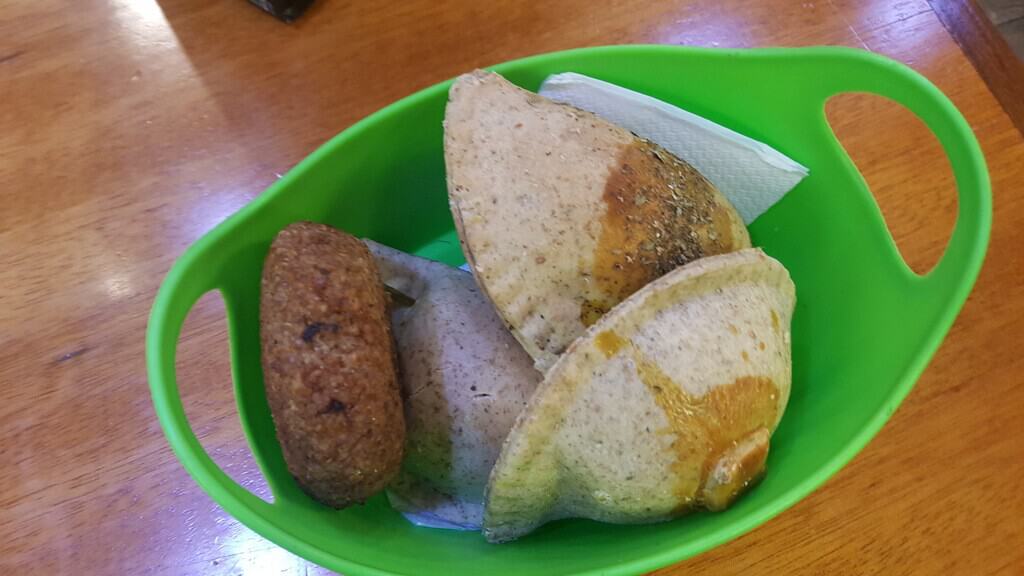
Veg+ is the health-shop alternative to Mundo Verde. They have branches in Copacabana, Ipanema, and Barra da Tijuca. There’s a small baked goods section with vegan salgados. The only downside is they mostly use soya as a meat and milk replacement.
Rio’s Water quality
Locals mostly use water filters. However, bottled mineral water like “Petropolis” is high quality and cheap. Be careful with other brands that contain sodium-fluoride which may pose health risks. Since the weather is quite hot throughout the year, warm drinks like tea are uncommon in Rio. But generally, boiled tap water is considered to be reasonably safe for consumption.
Rio de Janeiro Fitness and Workout Options
Capoeira
In the early colonial days of Brazil, the slaves from Africa had to disguise their fight-training as a dance. The slave owners prohibited them from learning to fight, and thus Capoeira was born. For this reason, Capoeira musical instruments are played during fights.
During Capoeira you’ll be continuously in motion. When the opponent launches an attack, you immediately react with a defense. In this way, you improve your reaction time whenever you are in a position that genuinely requires self-defense. The only negative is that it can be hard on your knees, since while fighting you are basically semi-crouched the whole time. Balancing on your knees, while swaying from side to side.
In Rio, you’ll find opportunities to practice and do a Capoeira intro class, for the same price as a gym day pass …about 30 Reals.
Brazilian Jujitsu
If this doesn’t sound interesting to you, then try Brazilian Jujitsu. This is a fighting style where the goal is first to get the opponent off his/her feet and then onto the ground. Next, you wrestle the opponent into submission. There are a lot of different moves to learn. These techniques need to be executed to perfection within quick succession. If you leave too much space for the opponent to maneuver, he can extract himself from your lock-down, and pin you down instead.
Apart from giving you a few basic self-defense skills, Brazilian Jujitsu can also boost physical coordination and agility. Moreover, it’s also a good workout for your brain and memory power, since you need to remember the different positions and sequences, or otherwise lose the fight! Plus, of course, you gain self-discipline if you show up and train regularly to master the sport.
It’s one of the most popular sports in Rio de Janeiro. Not as popular as football/soccer though. Although hand-to-hand combat isn’t as useful anymore in the age of fire-arms, Jujitsu teaches techniques to disarm opponents holding guns and knives. Thus, local police officers often participate in training.
The Fitness Options
Smartfit charges from 25 Reals per workout. It’s probably the cheapest work-out option in Rio’s touristic neighborhoods. Some of their branches (and there are plenty) are very small. I’d rather avoid these. It’s the same price as the larger branches, so find the larger Smartfit gym’s. It’s much better value for money, there are more machines and less congestion during evening peak hours.
On the other hand, Bodytech was way too expensive. About 160 reals for one work-out. Crazy price, but this was in Ipanema – one of the most expensive neighborhoods in Latin America. Here’s a rule of thumb: In Brazil, avoid all Bodytech gyms if you’re a tourist – they’re overpriced.
Smart fit is a much better option in Ipanema. Otherwise, in the tranquil and pleasant Leme neighborhood (next to Copacabana), Ox fitness was a very good workout option for 30 Reals.
For a free beach workout, there are iron bars available every few 100 meters or so on the promenade as you walk all the way from Copacabana to Ipanema. You can do some pull-ups and triceps dips on these contraptions, but unless you’re a calisthenics master, it’s not enough for a quality full-body workout.
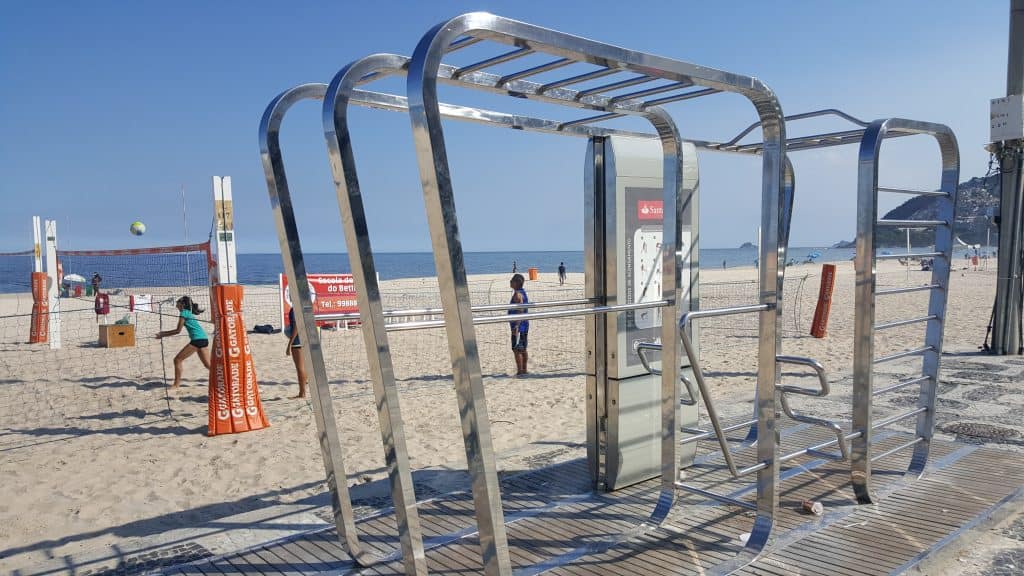
There is also a free open-air gym right in between Copacabana and Ipanema, at the Parque do Arpoador. Very basic equipment, but if your hotel is in this area, then its worth checking out.
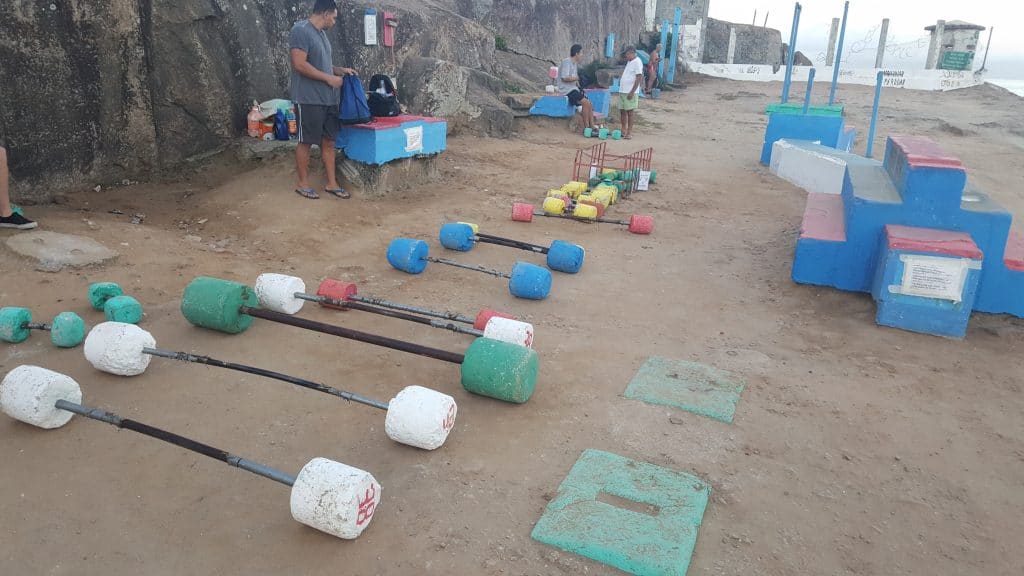
As in other cities, you’ll find CrossFit, and yoga options. Plus, hiking and climbing options are very promising. Of course, there’s also beach volleyball. And what better place to go for a jog than right next to Ipanema or Copacabana beach – on the separate lane for jogging and cycling. Or even better (for a great calves-muscle workout): run on the beach itself.
Here are a few more gyms I visited to workout and/or to get day-pass info. It’s not that easy to get a free trial workout in Rio since most gyms would immediately suspect you’re a tourist who wants to avoid paying.
- Smart fit in Ipanema at Av. Gen. San Martin 512: Way too small gym. Waste of money. No heavy-weights. No bench press. Skip this one. Too congested.
- Smart fit Gavea: This gem of a gym is hidden away in the Jockey Club of Gavea (close to Leblon). It’s large and spacious with all the equipment you need. Price R$25. If you’re staying close, this gym is top value for money.
- Academia ProQuality Ipanema: R$50 per workout. Gym looked spacious and modern. But I didn’t feel like paying that much, so I went to Smartfit Gavea instead.
- Le Gym Gavea: Looked like a very modern gym. R$42 per workout. Twice the price of Smartfit though, across the road.
- Academia Formula (Copacabana): Modern gym, but not that large. Price for a once-off workout was R$75, which is too expensive. For one week, the price is more reasonable: R$150.
- Smart Fit (Av. Nossa Sra. de Copacabana 749): Relatively large gym, one underground floor. I recommend avoiding peak hours. It can be a fight to get the machine you want. Even then, other gym-goers might interrupt you and ask you to alternate sets with them. The price is R$25 per workout.
- Smart Fit (Rua Pompeu Loureiro 35 – Copacabana): A small Smart Fit gym. Staff told me the Nossa Senhora branch (above), is much larger, so I went there instead.
Rio de Janeiro Hiking
Pedra Bonita: The most tourist-friendly hike in central Rio
Pedra Bonita is the easiest and most accessible central hike for tourists. It takes around 45 minutes to the top and 45 mins back down (if you hike at an easy pace). To reach this hike, take the Metro to Sao Conrado station. Then you have the option of either taking a Taxi / Ride-sharing App to Pedra Bonita’s starting point, otherwise, you can take the bus. The hike is free, but you need to sign in at the beginning at a small booth.
It’s in a decent area of Rio, thus you’ll feel relatively safe doing this hike with a friend or two. There’s no need to pay a tour guide. But at the same time, hiking completely alone in Rio is never a great idea. At the top, take some photos and enjoy the great view of Barra da Tijuca, Sao Conrado, and Ipanema.

Pedra Telegrafo: The Most Instagram-friendly hike in Rio
Since there’s so much natural beauty in Rio, there are plenty more hiking options, e.g. the Telegraph stone. This is a rock that hangs above the ground in such a way that you can fake standing above a deep abyss. While in reality the soil is 1.5 meters below the stone. The nice ocean and jungle backdrop helps make this an extra special photo opportunity.
A negative is that you’d have to stand in line waiting for your turn to take a photo on top of the telegrafo. And of course, you can’t linger forever, as the other hikers would expect you to take your photos, and move on. Beware of the professional-looking guy with the camera and leaflet selling photos to tourists. Both me and my hiking companion paid them R$10 for extra photos, which was never delivered. Luckily we took our own photos as well.
It takes around one hour to get to the top of the hike. Or less if you’re fit. It did not feel like a strenuous hike, but it was a good leg workout nevertheless. Dress light, since humidity is high.
As with Pedra Bonita, you don’t need to pay a tour guide to reach the hike. First take the metro train to Jardim Oceanico. Then, take 2 buses to the starting point. The buses took around 70 minutes. Total cost will thus be three transport tickets (R$4.05 each) both ways. Thus six in total (R$25). If you use the app “Moovit” it’s easy to find out which buses to take.
As always in Rio, don’t hike alone. Plus, it helps to have a friend with you to capture the moment with a few smart-phone photos.
View this post on Instagram

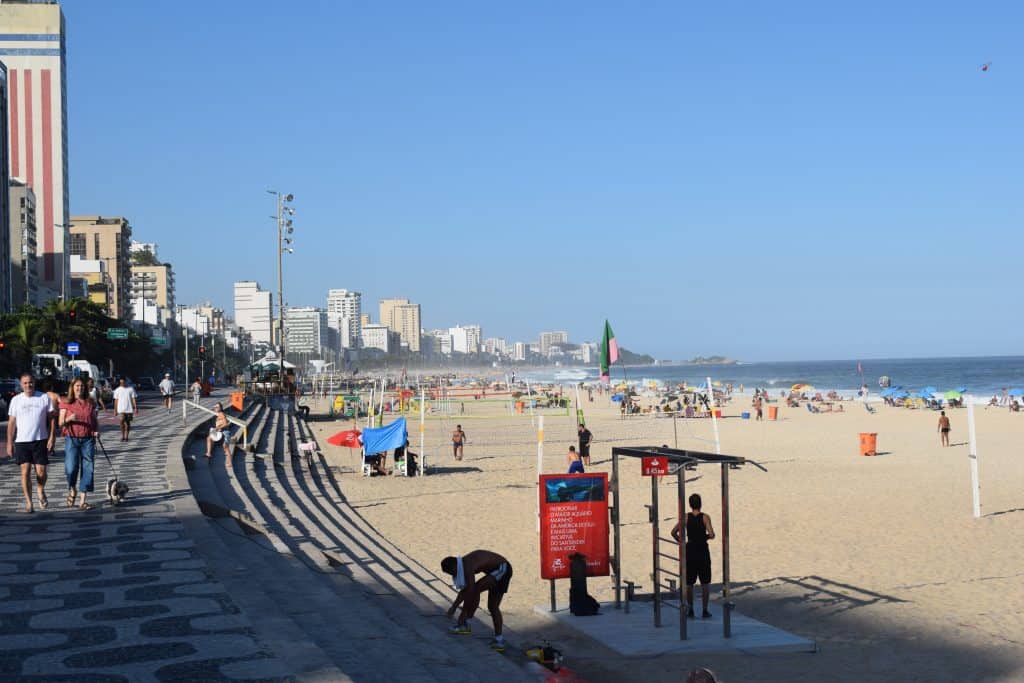

Other Rio de Janeiro Tourist Information
Safety in Rio
Don’t walk around Rio with your camera around your neck. You can still take photos with your cell phone. Simply keep your valuables out of sight all the time and you should be (relatively) OK. Don’t flash your cash (or other valuables). The local women wear fake jewelry in Rio, in order to not tempt thieves.
Due to Copacabana Beach’s crime problem, the previous government took the extreme measure of making the army do regular patrols along the beach. However, the current government is working on strengthening Rio’s police service instead.
Copacabana is safer than Downtown Rio at night, but it’s still recommended to be careful. Ipanema is the safest (reasonably) central place to stay in Rio. Neighborhoods like Botafogo pose safety risks after dark. Avoid quiet streets, or you may get mugged.
Weather in Rio
It’s almost always sunny in Rio, at least up to April, it gets slightly colder in May. During this time it also gets dark very early at night, at about 5h30pm. At its coldest, in the middle of winter (June/July) the minimum temperature will still remain above 15 degree Celsius.
Although temperatures are warm in summer, due to tropical weather, December is the wettest month of the year. During the Summer wet days, the beaches are much emptier. But when the sun is shining, remember your sunscreen or regret it the next day!
Where to stay
Copacabana is a good intermediate place to stay, both location and cost-wise between the upmarket Ipanema, and the poor central neighborhoods of Rio. If you can afford it and don’t mind paying more for restaurants, then stay in Ipanema. Otherwise on a budget, choose Copacabana for the full “Rio experience” including fresh coconut water on the beach every day, Acai, and basically having a central location from which you can explore the rest of the city.
I would choose either the laid-back residential part of Copacabana close to Leme, from where you can also easily reach Shopping Rio Sul, Botafogo and the not-so-touristic city center (which is only really nice to spend a couple of hours in). Otherwise, the other end (of Copa) close to Ipanema (and the Arpoador), is also very decent and touristic. Moreover, Urca is a pleasant neighborhood, with a good beach, to visit – but I won’t stay there since it’s a little far away from the action.
Unless you prefer hotels, Airbnb can help with your accommodation needs: Click here for $40 discount off your first stay, plus $15 off your first Airbnb Experience.
For transport, you can take the underground train to the furthest end of Ipanema (Leblon beach), or even a little further on to Sao Conrado and Barra da Tijuca’s beaches. The same metro line also goes in the opposite direction towards the city center (e.g. Lapa).
If you don’t love taking trains, use a ride-sharing app like 99 Taxi. It’s cheaper than the official taxis. If you don’t speak Portuguese, simply tell the driver your name when you arrive, and your destination. Plus you could say: “Nao Falo Portugues” (translation: “I don’t speak Portugues”). They’ll understand and take you to your destination.
Rio de Janeiro Health Travel Junkie Challenge
Easy Challenge: Drink all the water from a fresh coconut on the beach.
Advanced Challenge: Take the empty coconut home, find a way to chop it open safely (or ask the stall owner to chop it open for you), then blend the creamy white coconut meat into a smoothie. This can be a very simple recipe e.g. coconut meat, water, a banana, or honey.
Rio Health Travel Junkie Scale
Fitness activities – 8
(plenty of decently priced options)
Food – 8
(Tasty seafood, and a few good buffet options.)
Cost of traveling – 7.5
(Accommodation is affordable, but restaurants aren’t always cheap. Taking taxis to different neighborhoods can contribute to expenses.)
Other Wellness-related activities – 8
(Hiking, Great beaches, Fresh coco water, Opportunities to train in Brazilian sport)
Overall rating: 80%
After visiting Rio, good options are taking the bus to either Belo Horizonte (8 hours away) or otherwise Sao Paulo (6 hours – not that touristic, more an industrial / business center and transport hub).
What did you think about Food and Wellness in Rio de Janeiro? Do you have any further tips to share (or questions)? Post a comment below to help fellow travelers have the best time in Rio.

